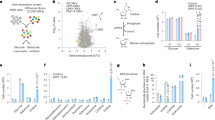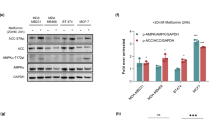Abstract
Activation of the oncogenic kinase Akt stimulates glucose uptake and metabolism in cancer cells and renders these cells susceptible to death in response to glucose withdrawal. Here we show that 5-aminoimidazole-4-carboxamide ribonucleoside (AICAR) reverses the sensitivity of Akt-expressing glioblastoma cells to glucose deprivation. AICAR's protection depends on the activation of AMPK, as expression of a dominant-negative form of AMPK abolished this effect. AMPK is a cellular energy sensor whose activation can both block anabolic pathways such as protein synthesis and activate catabolic reactions such as fatty acid oxidation to maintain cellular bioenergetics. While rapamycin treatment mimicked the effect of AICAR on inhibiting markers of cap-dependent translation, it failed to protect Akt-expressing cells from death upon glucose withdrawal. Compared to control cells, Akt-expressing cells were impaired in the ability to induce fatty acid oxidation in response to glucose deprivation unless stimulated with AICAR. Stimulation of fatty acid oxidation was sufficient to maintain cell survival as activation of fatty acid oxidation with bezafibrate also protected Akt-expressing cells from glucose withdrawal-induced death. Conversely, treatment with a CPT-1 inhibitor to block fatty acid import into mitochondria prevented AICAR from stimulating fatty acid oxidation and promoting cell survival in the absence of glucose. Finally, cell survival did not require reversal of Akt's effects on either protein translation or lipid synthesis as the addition of the cell penetrant oxidizable substrate methyl-pyruvate was sufficient to maintain survival of Akt-expressing cells deprived of glucose. Together, these data suggest that activation of Akt blocks the ability of cancer cells to metabolize nonglycolytic bioenergetic substrates, leading to glucose addiction.
This is a preview of subscription content, access via your institution
Access options
Subscribe to this journal
Receive 50 print issues and online access
$259.00 per year
only $5.18 per issue
Buy this article
- Purchase on Springer Link
- Instant access to full article PDF
Prices may be subject to local taxes which are calculated during checkout







Similar content being viewed by others
References
Berwick DC, Hers I, Heesom KJ, Moule SK and Tavare JM . (2002). J. Biol. Chem., 277, 33895–33900.
Bolster DR, Crozier SJ, Kimball SR and Jefferson LS . (2002). J. Biol. Chem., 277, 23977–23980.
Brivet M, Slama A, Saudubray JM, Legrand A and Lemonnier A . (1995). Ann. Clin. Biochem., 32 (Part 2), 154–159.
Carlson M . (1999). Curr. Opin. Microbiol., 2, 202–207.
Corton JM, Gillespie JG, Hawley SA and Hardie DG . (1995). Eur. J. Biochem., 229, 558–565.
Culmsee C, Monnig J, Kemp BE and Mattson MP . (2001). J. Mol. Neurosci., 17, 45–58.
Dang CV and Semenza GL . (1999). Trends Biochem. Sci., 24, 68–72.
Danial NN, Gramm CF, Scorrano L, Zhang CY, Krauss S, Ranger AM, Datta SR, Greenberg ME, Licklider LJ, Lowell BB, Gygi SP and Korsmeyer SJ . (2003). Nature, 424, 952–956.
Davies SP, Sim AT and Hardie DG . (1990). Eur. J. Biochem., 187, 183–190.
Diserens AC, de Tribolet N, Martin-Achard A, Gaide AC, Schnegg JF and Carrel S . (1981). Acta Neuropathol. (Berl.), 53, 21–28.
Elstrom RL, Bauer DE, Buzzai M, Karnauskas R, Harris MH, Plas DR, Zhuang H, Cinalli RM, Alavi A, Rudin CM and Thompson CB . (2004). Cancer Res., 64, 3892–3899.
Gottlob K, Majewski N, Kennedy S, Kandel E, Robey RB and Hay N . (2001). Genes Dev., 15, 1406–1418.
Halford NG and Hardie DG . (1998). Plant Mol. Biol., 37, 735–748.
Hardie DG . (2003). Endocrinology, 144, 5179–5183.
Hashimoto K, Kato K, Imamura K, Kishimoto A, Yoshikawa H, Taketani Y and Esumi H . (2002). Biochem. Biophys. Res. Commun., 290, 263–267.
Horman S, Browne G, Krause U, Patel J, Vertommen D, Bertrand L, Lavoinne A, Hue L, Proud C and Rider M . (2002). Curr. Biol., 12, 1419–1423.
Inoki K, Zhu T and Guan KL . (2003). Cell, 115, 577–590.
Jijakli H, Nadi AB, Cook L, Best L, Sener A and Malaisse WJ . (1996). Arch. Biochem. Biophys., 335, 245–257.
Kato K, Ogura T, Kishimoto A, Minegishi Y, Nakajima N, Miyazaki M and Esumi H . (2002). Oncogene, 21, 6082–6090.
Kersten S, Desvergne B and Wahli W . (2000). Nature, 405, 421–424.
Kovacic S, Soltys CL, Barr AJ, Shiojima I, Walsh K and Dyck JR . (2003). J. Biol. Chem., 278, 39422–39427.
Lilly K, Chung C, Kerner J, VanRenterghem R and Bieber LL . (1992). Biochem. Pharmacol., 43, 353–361.
Merrill GF, Kurth EJ, Hardie DG and Winder WW . (1997). Am. J. Physiol., 273, E1107–E1112.
Moon A and Rhead WJ . (1987). J. Clin. Invest., 79, 59–64.
Mu J, Brozinick Jr JT, Valladares O, Bucan M and Birnbaum MJ . (2001). Mol. Cell, 7, 1085–1094.
Omura S, Sasaki Y, Iwai Y and Takeshima H . (1995). J. Antibiot. (Tokyo), 48, 535–548.
Rolfe DF and Brown GC . (1997). Physiol. Rev., 77, 731–758.
Van Meir EG, Kikuchi T, Tada M, Li H, Diserens AC, Wojcik BE, Huang HJ, Friedmann T, de Tribolet N and Cavenee WK . (1994). Cancer Res., 54, 649–652.
Wolfrum C, Asilmaz E, Luca E, Friedman JM and Stoffel M . (2004). Nature, 432, 1027–1032.
Warburg O . (1956). Science, 124, 269–270.
Acknowledgements
We thank Dr Morris Birnbaum for providing the dnAMPK plasmid and the AMPK antibody, Casey Fox, Aimee Edinger, and the rest of the Thompson laboratory for technical help, discussions and comments on the manuscript. This work was supported in part by grants from the NIH and NCI. RGS is supported by the Cancer Research Institute. RJD is supported by an NIH Training Grant (5T32-GM008638-08). GH is a Damon Runyon Fellow supported by the Damon Rynyon Cancer Research Foundation (DRG- #1714-02).
Author information
Authors and Affiliations
Corresponding author
Additional information
Supplementary Information accompanies the paper on Oncogene website (http://www.nature.com/onc)
Supplementary information
Rights and permissions
About this article
Cite this article
Buzzai, M., Bauer, D., Jones, R. et al. The glucose dependence of Akt-transformed cells can be reversed by pharmacologic activation of fatty acid β-oxidation. Oncogene 24, 4165–4173 (2005). https://doi.org/10.1038/sj.onc.1208622
Received:
Accepted:
Published:
Issue Date:
DOI: https://doi.org/10.1038/sj.onc.1208622
Keywords
This article is cited by
-
HSD17B4 methylation enhances glucose dependence of BT-474 breast cancer cells and increases lapatinib sensitivity
Breast Cancer Research and Treatment (2023)
-
Proton export upregulates aerobic glycolysis
BMC Biology (2022)
-
Simultaneously targeting SOAT1 and CPT1A ameliorates hepatocellular carcinoma by disrupting lipid homeostasis
Cell Death Discovery (2021)
-
TSP50 promotes the Warburg effect and hepatocyte proliferation via regulating PKM2 acetylation
Cell Death & Disease (2021)
-
VersicanV1 promotes proliferation and metastasis of hepatocellular carcinoma through the activation of EGFR–PI3K–AKT pathway
Oncogene (2020)



